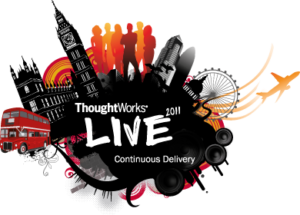 Last week I had the pleasure of attending ThoughtWorks Live 2011 in London’s St Martin’s Lane hotel. The conference, entitled Continuous Delivery: Push the button, was a showcase of ThoughtWorks thinking on how to become truly agile through the implementation of Continuous Delivery and Continuous Deployment.
Last week I had the pleasure of attending ThoughtWorks Live 2011 in London’s St Martin’s Lane hotel. The conference, entitled Continuous Delivery: Push the button, was a showcase of ThoughtWorks thinking on how to become truly agile through the implementation of Continuous Delivery and Continuous Deployment.
Among the speakers were heavyweights such as Martin Fowler, ThoughtWorks Chief Scientist & Roy Singham, ThoughtWorks Founder & Chairman – positioning ThoughtWorks as not only global experts but as global educators, both practically and aspirationally.
Riding Paradox

A real favourite for me was a presentation given by ThoughtWorks Studio’s Managing Director, Cyndi Mitchell on Adaptive Leadership: Accelerating enterprise agility, based on Jim Highsmith’s whitepaper of the same name. In the presentation Cyndi discussed a number of challenges that leaders face in being adaptive. The real eureka moment for me, in both the presentation and the whitepaper, was the concept of Riding Paradox. We were encouraged to be ‘And’ rather than ‘Or’ leaders, inclusive of elements from multiple methodologies that can add value and work together for the benefit of the project. No one methodology has it 100% right and we should look to take aspects of different practices and thinking and incorporate them more. A quote from Rotman summed it up well “Integrative Thinking is the ability to constructively face the tensions of opposing models, and instead of choosing one at the expense of the other, generating a creative resolution of the tension in the form of a new model that contains elements of the both models, but is superior to each“.
Highsmith discusses in his whitepaper “The paradox horse seems always to be going in opposite directions at the same time. Furthermore, the leader is exposed, drawn by the traditional norms of many organizations in which it’s OK to be wrong, but not OK to be uncertain“.
As a Business Analyst I often find myself in a similar position, for two reasons. Firstly, due to the nature of my role I report into my Managing Director for the purpose of sales targets and planning, while reporting into my Technical Director for the purpose of scoping and quality assurance. It can often feel like attempting to serve two masters, serving two areas of the business who sometimes have opposing expectations.
Secondly, clients can sometimes be prescriptive about the methodology that their software project should use. This is rarely based on thoughtful consideration of stakeholder needs, rather that the client has heard a buzz word or has used that methodology on a previous project and feels safe with it. As an example, I have had clients come to me and say “We want to use Prince2”, for no other reason then a third-party advisor has suggested it would ‘be best’. This leads to lengthy planning and scoping phases of work up-front which the client is happy with. However, once the project moves into production the development team opt to take an agile approach to the job, breaking down my long specification into chapters – renaming them iterations and delivering little and often.Watch Full Movie Online Streaming Online and Download
At the same conference one of the speakers, Dave West from Forrester, coined the phrase “Water-Scrum-Fall” that perfectly describes this idea that scoping happens, the development team run off with an agile approach and then the final mile of the project reverts back to a very formalised sign-off process.
I’m excited by what I’ve heard at the conference and challenged to implement changes in my working practice. Lets hope I can attempt to ride paradox without falling off!
Rotman. (n.d.). Integrative Thinking. Retrieved from Rotman Business School [online]. Available from: http://www.rotman.utoronto.ca/integrativethinking/definition.htm
Highsmith, Jim. 2011. Adaptive Leadership: Accelerating enterprise agility [online]. Available from: http://www.thoughtworks.com/articles/adaptive-leadership-accelerating-enterprise-agility
Image from: Jim Highsmith: “And” Leadership.

